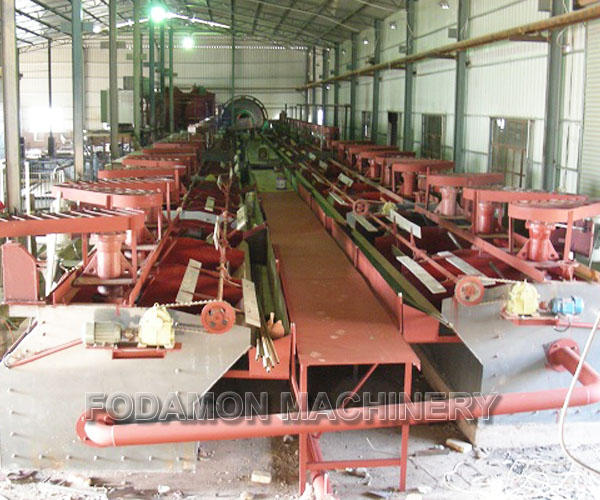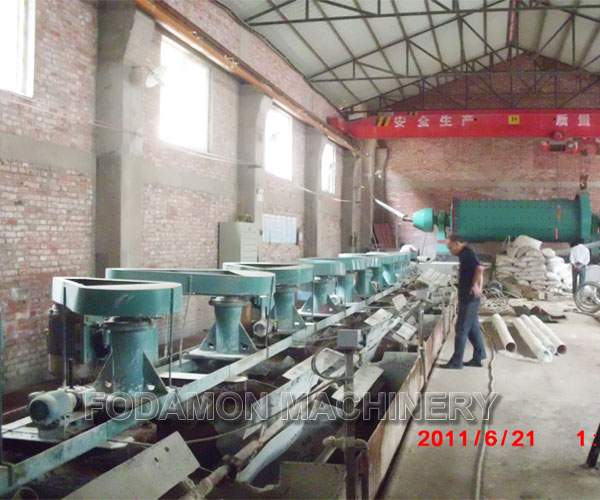Fluorite (CaF2) contains F48.9%, CaSl.1% fluorite has good floatability, and fatty acids are often used as collectors. The pH of the pulp has a great influence on the flotation effect of fluorite. Using oleic acid as a collector, when the pH of the pulp is 8-11, the fluorite has better buoyancy. Secondly, raising the temperature of the slurry can also increase the flotation index of fluorite. At the same time, the flotation behavior of fluorite with different particle sizes is also different. The coarse-grained fluorite flotation is characterized by strong selectivity; therefore, its concentrate grade is high, but the recovery rate is low; the medium-grained fluorite flotation results in higher concentrate grade and recovery rate; fine-grained fluorite float The selected concentrate grade and recovery rate are both low. When flotation fluorite uses oleic acid as a collector, there is also a higher requirement for floating water. When the water quality is hard water, the water entering the flotation process is first softened.
Fluorite flotation collectors In addition to oleic acid, hydrocarbyl sulfates, alkylsulfonated succinamines, sodium oleoyl sulfamate and other sulfonates and amines can be used as collectors for fluorite flotation. Commonly used sodium carbonate as a pulp conditioner. Depending on the nature of the gangue, water glass, sodium metaphosphate, lignosulfonate, dextrin, etc. can be used as the gangue inhibitor.

Fluorite flotation method
The main problem with fluorite flotation is the separation from symbiotic gangues (such as quartz, calcite, barite, etc.). There is also the problem of separation from certain sulfides. Depending on the situation, the following methods can be used:
(1) Fluorite ore containing sulphide ore
Generally, the xanthate collector is used to float the sulfide ore, and then the fatty acid agent is used to float the fluorite. Sometimes in the fluorite flotation operation, a small amount of sulfide ore inhibitors (such as cyanide) is added to suppress residual sulfide to ensure the quality of the fluorite concentrate.

(2) Separation of fluorite and barite and calcite
Generally, oleic acid is used as a collector to float fluorite. When fluorite is floated with oleic acid, a small amount of aluminum salt is added to activate the fluorite, and dextrin is added to suppress the barite and calcite.
For fluorite ore containing more calcite, limestone, dolomite, etc., it is better to suppress these gangue minerals with tannins and lignosulfonates.

(3) Separation of fluorite from quartz
The fatty acid is used as a collector to float fluorite, the water glass is used as an inhibitor of quartz, and the sodium carbonate is adjusted to have a pH of 8-9. The amount of water glass should be controlled well. When it is small, it can activate fluorite, but the inhibition of quartz is not enough. When it is excessive, fluorite will be inhibited. In order to minimize the amount of added water glass and to achieve the inhibition strength of quartz gangue, it is often added with water glass, and then added polyvalent metal ions (such as Al3+, Fe3+) and alum, aluminum sulfate and the like. In addition, the addition of Cr3+ and Zn2+ ions is also effective, and these ions not only inhibit quartz but also calcite.
(4) Separation of fluorite and barite
Fluorite and barite are generally mixed and floated, and then separated. In the mixed flotation, oleic acid is used as a collector, and water glass is used as an inhibitor. The following methods can generally be used for the separation of mixed concentrates:
1) inhibiting barite with dextrin or tannin with iron salt, and fluorite with oleic acid;
2) The barite is floated with a hydrocarbyl sulfate, and the fluorite concentrate is left in the flotation cell.
